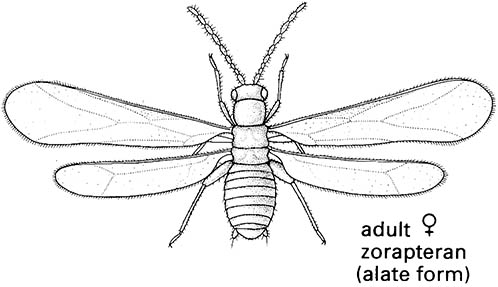Box 9.6. Zoraptera
These insects comprise the single genus Zorotypus, sometimes subdivided into several genera, containing just over 30 described species found worldwide in tropical and warm temperate regions except Australia. They are small (<4 mm long) and rather termite-like. The head is hypognathous, and compound eyes and ocelli are present in winged species but absent in apterous species. The antennae are moniliform and nine- segmented, and the mouthparts are mandibulate, with five-segmented maxillary palps and three-segmented labial palps. The subquadrate prothorax is larger than the similar-shaped meso- and metathorax. The wings are polymorphic; some forms are apterous in both sexes, whereas other forms are alate, with two pairs of paddle-shaped wings with reduced venation and smaller hind wings (as illustrated here for Zorotypus hubbardi, after Caudell 1920). The wings are shed as in ants and termites. The legs have well-developed coxae, expanded hind femora bearing stout ventral spines, and two-segmented tarsi, each with two claws. The 11-segmented abdomen is short and rather swollen, with cerci comprising just a single segment. The male genitalia are asymmetric.
The immature stages are polymorphic according to wing development. Zorapterans are gregarious, occurring in leaf litter, rotting wood, or near termite colonies, eating fungi and perhaps small arthropods. Phylogenetically they are enigmatic, with a probable relationship within the Polyneoptera (see section 7.4.2 and Fig. 7.2).


Broken lines indicate uncertain relationships. Thysanura sensu lato refers to Thysanura in the broad sense. (Data from several sources)



